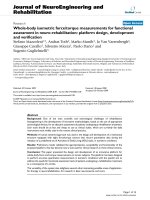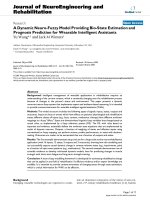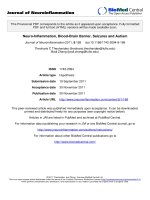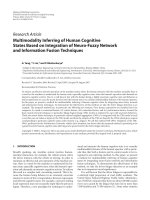Neuro image2008
Bạn đang xem bản rút gọn của tài liệu. Xem và tải ngay bản đầy đủ của tài liệu tại đây (8.14 MB, 70 trang )
Clinical & Functional
Neuroimaging:
A window on the living brain
Clara Moisello
M. Felice Ghilardi
IMAGING THE LIVING BRAIN
Brain Structure
Skull, Brain anatomy, Vessels
Spinal cord
Brain Function
At Rest, During tasks
Structure: Skull
X-Rays
Absorbed by Calcium, identify bone structures and calcifications
Structure: Ventricles
Pneumoencephalography
Substitution of CSF with air. It visualizes the ventricular system.
Structure: Brain Vessels
Angiography
X-ray and injection of radio-opaque material
Structure: Brain Vessels
Angiography
Anterior & Lateral views of L carotid Artery
Structure: Brain Vessels
Angiography
Diagnosis:
Subarachnoidal hemorrhage, Intracerebral Hemorrhage
Tromboembolic stroke, to evaluate carotid vessels and intracranial vessels
Arterial dissections
Vasculitis
Tumors at the base of the skull
Interventional neuroradiology:
Embolization of vascular malformations and tumors
Occlusion of carotid by detachable balloons
Angioplasty
Type of imaging
Anatomic
Computed Tomography (CT)
Tissue density
Xenon-enhanced CT
Xenon concentration in Blood
Magnetic Resonance Imaging (MRI)
Many properties of tissue
Functional
Positron Emission Tomography (PET)
tracers in blood/tissue
Single photon emission CT (SPECT)
tracers in blood/tissue
fMRI
BOLD signal
hd-EEG
Sum of neuronal discharge
MRA
Blood Flow
MEG
Magnetic fields of neuronal discharge
Structure: Brain Regional Anatomy
CT scan
Transmission of X-rays through tissue measured by 180°-positioned XRay detector
Important parameters:
-Matrix Size (up to 512X512)
-Field Of View (FOV, ex. 20 cm)
-Slice Thickness (down to <1mm)
High resolution: large matrix, small FOV,
0.5 mm thick
Scale of CT absorption: -1000 to +1000
0=water
-1000=air
Structure: Brain Regional Anatomy, CT scan
Structure: Brain Regional Anatomy, CT scan
Tissue
Appearance
Calcified tissue
Clotted blood (1-2 wks)
Gray Matter
White Matter
CSF
Water
Air
White
White
Light gray
Medium gray
Nearly black
Nearly black
Black
Structure: Brain Regional Anatomy, CT scan
Slice Thickness:
Thinner slices
Allow visualization of smaller lesions;
But less contrast and longer scan duration
Thicker slices
Greater contrast but less resolution power, so small lesions can be missed.
Increase incidence of artifacts, particularly in the skull base
Structure: Brain Regional Anatomy, CT scan
Contrast agents:
Ionic, High osmolality;
Non ionic, Low osmolality
Useful when there are BBB breakdown
>> contrast in the extravascular space
Contrast will appear as a white area on the scan
Comparison with a non-contrast CT
Allergic reactions:
Immediate >> 1 hour
Delayed >> 24 h-7 days
Hives, rhinitis, broncospasm, laryngeal edema, hypotension, death.
Nausea, vomiting, warmth, pain, arythmias, tachycardia, hypotension
Structure: Brain Regional Anatomy, CT scan
Xenon-enhanced CT:
allows identification of structural lesions invisible to CT or MRI
uses stable Xe gas (radiodense and lipid soluble)
Baseline CT, then
Xe (26-30%) by inhalation mixed with O2
>> regional blood flow
Contrast will appear as a white area on the scan
Comparison with a non-contrast CT
Decreased flow has been documented in:
Meningitis
Vasospasm
Head Trauma
Sickle cell disease
Stroke
Structure: Brain Regional Anatomy, CT scan
Xenon-enhanced CT:
Left-sided weakness, 1.5 h later: Normal CT, luxury perfusion at Xe-CT
Structure: Brain Regional Anatomy, CT scan
Structure: Brain Regional Anatomy
MRI: complex interplay of the response of tissues to the applied magnetic field
H atoms in
absence of
magnetic field
Structure: Brain Regional Anatomy
MRI
Structure: Brain Regional Anatomy
MRI
The strength of the magnet is measured in Tesla (T)
Clinical setting: 1.5 T
Human Research setting: 3-4 T
Animal Research setting: up to 7-10 T
Structure: Brain Regional Anatomy
MRI
The combination of RF and magnetic field is called: PULSE SEQUENCE
Different pulse sequences are sensitive to different aspects of H+ behavior
A pulse sequence is repeated many times to form an image
The most common pulse used in clinical MRI is the spin echo (SE) sequence
Newest sequence acquisition: Fast spin echo (FSE)
Different pulse sequences emphasize different tissue properties, by varying
two factors: Time to recovery (TR, or repetition time) and Time to echo (TE,
time at which the receiver coil collects the signal after RF delivery)
TR
TE
Structure: Brain Regional Anatomy
MRI: sequences
T1
T2
FLAIR
Fast spin Echo, T2 reduction in scan time, less susceptibility
to ferromagnetic artifacts
Gradient-recalled echo: T2, more artifacts, blood-containing
lesions
Diffusion-Weighted, T2, acute ischemia
Fluid-attenuated Inversion Recovery (FLAIR), RF during
inversion time, CSF attenuated (black), T2, pathology of
periventricular regions, extra axial collections, lesions near
the brain surface
Perfusion-weighted: Gadolinium, highly paramagnetic (MF
657 times H+), BBB damage
Tumors
Proton Weighted: MS
Structure: Brain Regional Anatomy
MRI
T1
Gray matter
(msec)
980-1040
T2
64-71
White matter 740-770
64-70
CSF
>2000
>300
Muscle
600
40
Fat
180
90
Structure: Brain Regional Anatomy
MRI
Bone
Calcified tissue
Gray matter
White Matter
CSF
Water
Air
Pathology
Blood
Acute
Subacute
Structure: Brain Regional Anatomy
MRI
Side effects:
Headaches
Dizziness
Nausea
Contraindications:
Implanted devices that are composed wholly or partially of metal such as:
•
Pacemakers
•
Implanted medical pump
•
Metal in the head
Pregnancy, lactation
Structure: Brain Regional Anatomy
MRI vs. CT









